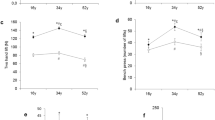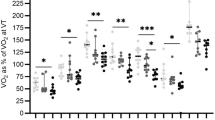Abstract
The basic characteristics of the cardiovascular system, physical capacity, and the degree of tension of regulatory mechanisms in the state of rest and under functional loading were identified on the basis of longitudinal studies in children of senior preschool and junior school ages, including boys and girls with low, medium, and high habitual physical activity (LHPA, MHPA, and HHPA). Analysis of the statistical distribution of traits using the χ2 and λ tests and the average statistical data on various functional indicators in the total sample identified a fairly wide area and qualitative differences in physiological individuality in a healthy population and the advisability of distinguishing three typological groups, i.e., functional types (FT-1, LHPA; FT-2, MHPA; FT-3, HHPA). The typological parameters of the first and second orders for each FT and performance test parameters of the third order describing the current functional state have been distinguished. Determination of the physiological features of FT-1, FT-2, and FT-3 with the establishment of their functional reserves and adaptive capacity permits the identification of different strategies of interaction between the body and the environment, estimation of their advantages and disadvantages, and a more reasonable approach to optimization of physical condition and premorbid diagnosis.
Similar content being viewed by others
References
Dmitriyeva, N.V. and Glazachev, O.S., Individual’noye zdorovye i poliparametricheskaya diagnostika funktsional’nykh sostoyaniy organizma (sistemno-informatsionny polkhod) (Individual Health and Polyparametric Diagnosis of Functional States of Body (System and Information Approach), Moscow, 2000.
Bayevsky, R.M., Concept of Physiological Norm and Criteria of Health, Ross. Fiziol. Zh. im. I.M. Sechenova, 2003, vol. 89, no. 4, p. 473.
Zaitseva, V. and Sonkin, V., Statistical and Physiological Distinction of Constitution Types, J. Physiol. Anthropol. Appl. Hum. Sci., 2005, vol. 24, no. 4, p. 327.
Bayevsky, R.M., Evaluation and Classification of the Levels of Health in View of the Theory of Adaptation, Vestn. Akad. Med. Nauk SSSR, 1989, no. 8, p. 73.
Sonkin, V.D. and Zaitseva, V.V., Age-Specific Dynamics of Physical Capacities of Schoolchildren (Bioenergetic Aspect), Teor. Prakt. Fizkul’t., 1990, no. 9, p. 26.
Sudakov, K.V., Glazachev, O.S., and Badikov, V.I., Experience of Using Systemic and Individual-Typological Approaches to Creation of Automated Devices for Premorbid Diagnosis, Vestn. Diagn. Nov. Med. Tekhnol., 1993, no. 2, p. 82.
Korniyenko, I.A., Son’kin, V.D., and Tambovsteva, R.V., Age-Specific Development of the Energetics of Muscle Performance: Results of 30-Year Research: III. Endogenous and Exogenous Factors Influencing the Development of Energetics of Skeletal Muscles, Fiziol. Chel., 2007, vol. 33, no. 5, p. 118.
Grigoryev, A.I. and Bayevsky, R.M., Kontseptsiya zdorovya v kosmicheskoy meditsine (The Concept of Health in Space Medicine), Moscow: Slovo, 2007.
Agadzhanyan, N.A., Bayevsky, R.M., and Berseneva, A.P., Problemy adaptatsii i ucheniye o zdorovye (Adaptation Problems and the Doctrine of Health), Moscow: RUDN, 2006.
Kaznacheev, V.P., Bayevsky, R.M., and Berseneva, L.P., Donozologicheskaya diagnostika v praktike massovykh obsledovaniy naseleniya (Premorbid Diagnosis in the Practice of Mass Health Examinations), Leningrad: Meditsina, 1980.
Bayevsky, R.M., Berseneva, A.P., Bersenev, E.Yu., et al., Application of Principles of Premorbid Diagnosis for Estimation of the Functional State of Body under Stress impacts (by the example of bus drivers), Fiziol. Chel., 2009, vol. 35, no. 1, p. 41.
Medvedev, V.I., Adaptatsiya cheloveka (Human Adaptation), St. Petersburg: Institut Mozga Cheloveka RAN, 2003.
Kolpakov, V.V., Bespalova, T.V., Bragin, A.V., et al., The Concept of Typological Variation of Physiological Individuality. I. Intrapopulation Diversity of Habitual Physical Activity of Man and Its Model Estimation, Fiziol. Chel., 2008, vol. 34, no. 4, p. 121.
Kolpakov, V.V., Bespalova, T.V., Bragin, A.V., et al., The Concept of Typological Variation of Physiological Individuality. II. Population Divergence of Somatotypes in Groups of Subjects with Different Levels of Habitual Physical Activity, Fiziol. Chel., 2009, vol. 35, no. 4, p. 75.
Kolpakov, V.V., Bespalova, T.V., Larkina, N.Yu., et al., The Concept of Typological Variation of Physiological Individuality. III. Psychophysiological Features of Functional Types in Subjects with Different Levels of Habitual Physical Activity, Fiziol. Chel., 2009, vol. 35, no. 5, p. 88.
Sonkin, V.D., Zaitseva, V.V., Kulichevsky, D.V., et al., Human Constitution and Physical Health, in Fizicheskaya kul’tura individa (Physical Culture of Individual), Moscow: Vagrius, 1994.
Zaitseva, V.V., Sonkin, V.D., and Izaak, S.I., Individual’ny podkhod v fizicheskom vospitanii i ego realizatsiya na osnove kompyuternykh tekhnologiy (Individual Approach in Physical Education and its Realization on the Basis of Computer Technologies), Moscow: RGAFK, 1998.
Lange Anderssen, K., Rutenfranz, J., Masironi, R., et al., Habitual Physical Activity and Health, Copenhagen: WHO Reg. Publ. Eur., 1982, series 6.
Montoye, H.I. and Taylor, H.L., Measurement of Physical Activity in Population Studies a Review, Hum. Biol., 1984, vol. 56, p. 195.
Sukharev, A.G. and Sergeta, I.V., Hygienic Aspects of Setting Physical Activity Rates during the Spare Time of Adolescents, Gig. Sanitariya, 1994, no. 6, p. 25.
Grebneva, N.N. and Solovyev, V.S., Metody otsenki funktsional’nogo sostoyaniya kardiorespiratornoy sistemy cheloveka (Methods of Estimation of Functional State of Human Cardiorespiratory System), Tyumen’: Tyumensk. Gos. Univ., 1997.
Medvedev, M.A. and Studnitsky, V.B., Otsenka fizicheskogo zdorovya vzroslykh i detey metodom indeksov (Estimation of Physical Health of Adults and Children by the Method of Indices), Tomsk: Pechatnaya Manufaktura, 2006.
Lechebnaya fizkul’tura i vrachebny kontrol’ (Exercise Therapy and Health Care), Epifanov, V.A. and Apanasenko, G.L., Eds., Moscow: Meditsina, 1990.
Petrushina, A.D., Izbrannye voprosy pediatrii. Poliklinicheskaya pediatriya (Selected Questions of Pediatrics. Polyclinic Pediatrics, Tyumen’: Tsentr Akademiya, 2006.
Berseneva, A.P., Denisov, L.A., Bersenev, E.Yu., et al., Premorbid Diagnosis in Estimation of Health Level of Schoolchildren, Funkts. Diagn., 2006, no. 3, p. 5.
Mazurin, A.V. and Vorontsov, I.M., Propedevtika detskikh bolezney (Propedeutics of Children Diseases), St. Petersburg: Foliant, 1999.
Chimarov, V.M. and Krylov, V.I., Analiz kardiointervalogramm u detey (Analysis of Cardiointervalograms of Children), Tyumen’, 1988.
Kupriyanova, O.O., Characteristics of the Functional State of the Cardiovascular System in Children, in: Fiziologiya rosta i razvitiya detey i podrostkov (teoreticheskiye i klinicheskiye vorposy): rukovodstvo dlya vrachey (Growth and Development Physiology of Children and Adolescents (Theoretical and Clinical Questions): Guide for Physicians), in 2 vols., Baranov, A.A. and Shcheplyagina, L.A., Eds., Moscow: GEOTAR-Media, 2006.
Update on the 1987 Task Force Report on High Blood Pressure in Children and Adolescents: A Working Group Report from the National High Blood Education Program, Pediatrics, 1996, vol. 98, no. 4, p. 649.
Soergel, M.S. and Bursh. C., Oscillometric Twenty Four Hour Ambulatory Blood Pressure Values in Healthy Children and Adolescents: Multicenter Trial Including 1141 Subjects, Pediatrics, 1997, vol. 130, no. 5, p. 178.
Behrman, R.E., Kliegman, R.M., and Arvin, A.M., Nelson Textbook of Pediatrics, W.B. Saunders, 2000, 16th edition.
Aulik, I.V., Opredeleniye fizicheskoy rabotosposobnosti v klinike i sporte (Determination of Physical Capacity in Clinic and Sports), Moscow: Meditsina, 1990.
Khrisanfova, E.N., Konstitutsiya i biokhimicheskaya individual’nost’ (Constitution and Biochemical Insividuality), Moscow: Mosk. Gos. Univ., 1990.
Khrisanfova, E.N. and Perevozchikov, I.V., Antropologiya (Anthropology), Moscow: Vysshaya shkola, 2002.
Nikityuk, B.A., Human Constitution, Itogi Nauki Tekh., Ser. Antropologiya, 1991, no. 4, p. 149.
Belokon, N.A. and Kuberger, M.B., Bolezni serdtsa i sosudov u detey: Rukovodstovo dlya vrachey (Cardiac and Vascular Diseases in Children: Guide for Physicians), in 2 vols., Moscow: Meditsina, 1987, vol. 1.
Hojgard, M.V., Holstein-Rathlou, N.-H., Anger, E., and Kanters, J.K., Dynamics of Spectral Components of HRV during Changes in Autonomic Balance, Am. J. Physiol., 1998, vol. 275, no. 1, Pt 2, p. H213.
Karemaker, J.M., Autonomic Integration: The Physiological Basis of Cardiovascular Variation, J. Physiol. (London), 1999, vol. 517, p. 316.
Kotelnikov, S.A., Nozdrachev, A.D., Odinak, M.M., et al., Cardiac Rhythm Variation: Concept of Mechanisms, Fiziol. Chel., 2002, vol. 28, no. 1, p. 130.
Sabiryanov, A.R., Structure of Slow-Wave Variation of Hemodynamic Parameters as an Integral Characteristic of Activity of the Levels of Regulation of Circulatory System in Junior and Middle School Age Children, Extended Abstract of Doctoral (Med.) Dissertation, Kurgan, 2005.
Kuznetsova, O.V., Peculiar Features of Autonomic Regulation of Respiratory-Hemodynamic System in Children in the Age of 8–11, in: Al’manakh Novye issledovaniya (Novel Research: Collection of Works), Moscow: Verdana, 2004, nos. 1–2 (6–7), p. 232.
Kuznetsova, O.V. and Sonkin, V.D., Spectral Analysis of Variation in Cardiac Rhythms, Arterial Pressure and Respiration in Children Aged 8–11 years at rest, Fiziol. Chel., 2005, vol. 31, no. 1, p. 39.
Kuznetsova, O.V. and Sonkin, V.D., Autonomic Tone in the Links of Respiratory-Hemodynamic System in Junior Schoolchildren, Fiziol. Chel., 2009, vol. 35, no. 6, p. 94.
Shlyk, N.I., Sapozhnikova, E.N., Kirillova, T.G., et al., Typological Features of the Functional State of Regulatory Systems in Schoolchildren and Young Sportsmen as Estimated by the Data on Heart Rate Variability), Fiziol. Chel., 2009, vol. 35, no. 6, p. 103.
Tomilova, E.A., Peculiarities of Premorbid Diagnosis of Disturbances in Arterial Blood Pressure in Junior Schoolchildren, in Aktual’nye voprosy diagnostiki i lecheniya naibolee rasprostranennykh zabolevaniy vnutrennikh organov (Current Problems in Diagnosis and Therapy of the Most Widespread Diseases of Internal Organs) (Proc. 5th Therapeutic Forum), Tyumen’, 2008, p. 89.
Levushkin, S.P. and Sonkin, V.D., Problem of Optimization of Physical State of Schoolchildren by Means of Physical Education, Fiziol. Chel., 2009, vol. 35, no. 1, p. 67.
Kazin, E.M. and Blinova, N.G., Osnovy individual’nogo zdorovya cheloveka: Vvedeniye v obshchuyu i prikladnuyu valeologiyu (Bases of Individual Human Health: Introduction in General and Applied Valeology), Moscow: VDADOS, 2000.
Author information
Authors and Affiliations
Additional information
Original Russian Text © V.V. Kolpakov, T.V. Bespalova, E.A. Tomilova, N.Yu. Larkina, E.V. Mamchits, M.O. Chernogrivova, A.A. Kopytov, 2011, published in Fiziologiya Cheloveka, 2011, Vol. 37, No. 1, pp. 105–117.
Rights and permissions
About this article
Cite this article
Kolpakov, V.V., Bespalova, T.V., Tomilova, E.A. et al. Functional reserves and adaptive capacity of subjects with different levels of habitual physical activity. Hum Physiol 37, 93–104 (2011). https://doi.org/10.1134/S0362119711010063
Received:
Published:
Issue Date:
DOI: https://doi.org/10.1134/S0362119711010063




